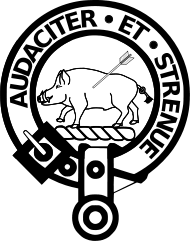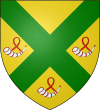Clan Pollock
Clan Pollock is an armigerous Scottish clan whose origin lies in a grant of land on the southern bank of the River Clyde, courtesy of King David I, to the sons of Fulbert from Walter fitz Alan, the 1st High Steward of Scotland, in the 12th century. It is among the oldest recorded surnames in Scotland.[1] The clan is a sept of Clan Maxwell.
| Clan Pollock | |||
|---|---|---|---|
 Crest: A boar passant shot through with a dart Proper | |||
| Motto | Audacter et Strenue (Boldly and earnestly) | ||
| Profile | |||
| Region | Lowlands | ||
| District | Renfrewshire | ||
 | |||
| Clan Pollock has no chief, and is an armigerous clan | |||
| Historic seat | Pollok Castle | ||
| |||
| |||
| |||
History
Origins of the clan
The clan can trace its origin to Fulbert "the Saxon",[2] a vassal knight of Walter fitz Alan from Oswestry, Shropshire, England. Fulbert came to Scotland with Walter fitz Alan in about 1136 and fought for Scotland at the Battle of the Standard at Northallerton in 1138. Fulbert's sons were granted land in Renfrewshire for the service of their father, a knight to Walter fitz Alan,[3] reconfirmed in a charter in 1157 by Malcolm IV. The family name is retained in placenames such as Pollok, Pollokshields and Pollokshaws, all situated to the south side of the River Clyde, between Glasgow city centre and Paisley.
The church of Pollock was given to the monks of the Priory of Paisley in 1163 by Petrus de Polloc, eldest son of Fulbert. As part of a dowry for one of his daughters, Petrus bestowed the barony of Rothes upon her. Robert de Polloc, Fulbert's third son, gave the church of Mearns to the Priory of Paisley. John de Polloc was a signatory to the Ragman Rolls subscribing allegiance to King Edward I of England in 1296.[4] John Pollok of Pollok fought on the side of Mary, Queen of Scots, at the Battle of Langside on 13 May 1568, only a few miles from Pollok Castle and, as a result, was forfeited of some of his lands. John Pollok, his son, was killed on 7 December 1593 at the Battle of Dryfe Sands near Lockerbie during a battle between Clan Maxwell and the Clan Johnstone. Robert Pollok of Pollok was knighted and made 1st Baronet of Pollok by Queen Anne in 1703 for his services to the crown.
Genetic history
Genetic testing has indicated Haplogroup R-M269, which is a subclade of Haplogroup R1b, and Haplogroup I-M223, which is a subclade of Haplogroup I2a, as prominent in male lineages.[5]
Clan profile
- Clan chief: Clan Pollock has no chief, and is an armigerous clan.
- Chiefly arms: A saltire Vert, 2nd, 3rd and 4th or buglehorns stringed and garnished.
- Motto: Audacter et strenue. The motto translates from Latin as "boldly and earnestly".
- Crest: A boar, shot through with an arrow proper.
- Tartan: Pollock Ancient and Pollock Modern.
Castles
Peerage
- Barony of Rothes (12th century)
- Baronets of Pollock
Notable bearers of the name
- Robert de Polloc, the son of Fulbert, used his seal about 1208. It shows a boar pierced by a dart and it is in the British Museum. The inscription starts at the top left and reads Sigillum Roberti De Polloc.
- John de Polloc signed the Ragman Roll subscribing allegiance to Edward I, in 1296. These four rolls consisted of thirty-five pieces sewn together; the originals have perished but a record of them is preserved in the Public Record Office.
- John Pollok fixed his seal, showing the Pollock arms, in 1453 on the charter of St Andrews College.
- Sir Robert Pollock of Pollock, knighted and made Baronet of Pollock, Member of Parliament.
- James Knox Polk, 11th President of the United States.
- Leonidas Polk, Confederate general and bishop of the Episcopal Diocese of Louisiana.
- Donald Ray Pollock, American author
- David Pollock (1739-1815), saddler to George III,[6] father of Sir Frederick and Sir George:
- Sir Frederick Pollock, 1st Baronet, British jurist and politician.
- Sir George Pollock, 1st Baronet, British Field Marshal and victor of the Battle of Kabul (1842).
- Sir Frederick Pollock, 3rd Baronet, British jurist.
- Ernest Pollock, 1st Viscount Hanworth, British jurist and a grandson of Sir Frederick Pollock, 1st Bt.
- Hugh MacDowell Pollock (1852–1937), Northern Ireland Minister of Finance.
- Sir J. Donald Pollock, Rector of the University of Edinburgh (1939-1945).
- Sir Michael Pollock, British Admiral of the Fleet and First Sea Lord.
- Oliver Pollock, financier of the American Revolution.
- James Dalgleish Pollock, Scottish recipient of the Victoria Cross.
- Graeme Pollock, South African cricketer.
- Paul Jackson Pollock, American abstract expressionist, whose father had been adopted by a family of the name.
- Peter Pollock, South African cricketer.
- Shaun Pollock, South African cricketer.
- William R. Pogue, astronaut, piloted American spacecraft Skylab 4. One of three to first achieve orbit for a continuous twelve weeks.
- Willis Polk, American Architect, rebuilt San Francisco after 1906 earthquake.
- Enid Blyton, by marriage, British children's writer.
- Joseph Pollock fought in World War II and received the Légion d'honneur.
- Alan Pollock, British Royal Air Force pilot, responsible for the Hawker Hunter Tower Bridge incident.
See also
Citations
- Crawford, George (1710). General Description of the Shire of Renfrew, Including an Account of the Noble and Ancient Families.
- Garrett, Mary Winder (April 1896). "PEDIGREE OF THE POLLOK OR POLK FAMILY FROM FULBERT THE SAXON (A. D. 1075) TO THE PRESENT TIME". The American Historical Magazine. 1 (2): 154–173. JSTOR 42657474.
- Ritchie, R. L. Graeme (1954). The Normans in Scotland. Edinburgh University Press. p. 280.
- Way (1994), pp.446-447.
- "Polk-Pollock-Pogue DNA Project: y-Results". Worldfamilies.net. Archived from the original on 23 May 2018. Retrieved 5 April 2018.
- "David Pollock the Saddler". Retrieved 16 May 2020.
References
- George Way of Plean and Romilly Squire Scottish Clan and Family Encyclopedia, Harper Collins, Glasgow, 1994. ISBN 0-00-470547-5